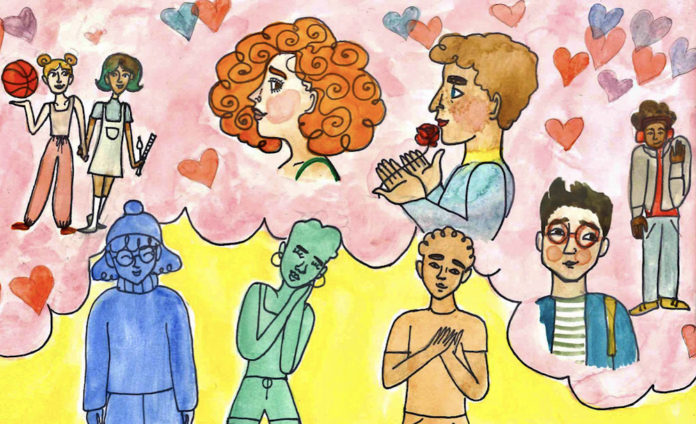This Valentine’s Day, while other people buy dozens of flowers for their crush or make elaborate brunch plans, I will be in my room watching Netflix’s newest romantic comedy, “To All the Boys 2: P.S. I Still Love You.” Equipped with my favorite chocolates, my closest (single) friends and the softest blankets, I look forward to getting lost in the adorable love story of Lara Jean and Peter Kavinsky.
I’m not the only fan of Netflix’s romantic comedies. As a result of the genre’s popularity, Netflix has released a total of 31 original romantic comedies in just three years. Skeptics tend to disparage this genre of film, placing these movies in the demeaning categories of “cash-grabs” or “chick flicks,” but the rise of the Netflix romantic comedy is something to celebrate. Modern romantic comedies are underestimated as a genre, relieve stress for the viewer and feature diverse women in front of and behind the camera.
The stigma surrounding romantic comedies has two causes: sexism that demotes women-centered stories and a failure to understand the diversity of the genre. Critics, who are overwhelmingly white men (not the target audience), tend to rate romantic comedies poorly, opposing the idea of a “chick flick” without critically examining what the genre is. In an op-ed for the New York Times, Gloria Steinem argues that many important works of fiction center around stories about women and romance. However, these works may not be hailed as classics if their authors were women — for example, if “Anna Karenina” had been by Leah Tolstoy or if Shakespeare was not a man but a lady. Mainstream audiences consider films about the female experience, especially romantic ones, less valid or serious than male-centered films about action or war.
Despite what the cynical critics say, romantic comedies aren’t all the same plot of some big city girl moving to a small town. Movies that aren’t considered romantic comedies such as “Groundhog Day” and the “Princess Bride” have romantic and comedic elements. There are romantic comedies about sports, like “Love and Basketball,” and about stand-up comedy, like “The Big Sick.” There is a type of romantic comedy for every viewer, even those skeptical of the genre.
Because of this stigma and the fact that millennials prefer to watch films at home, Netflix’s romantic comedies have become increasingly popular. Before Netflix started releasing romantic content, the theatrically-released romantic comedy was dying. In just 15 years, romantic comedies went from being 18 percent to 5 percent of all grossing (most profitable) films. Netflix’s model is better at catering to what people need when watching a romantic comedy: comfort. There is no longer the hassle of going out, nor the guilt of wasting money on what critics (both professional critics and cranky grandpas) deem as frivolous entertainment.
Romantic comedies, although often light and fun, also serve a crucial psychological purpose: stress relief. Research shows that watching a comedy activates the parts of the brain used for balancing mood. Likewise, a 2012 study reveals that watching programming with familiar patterns (such as the sometimes formulaic love stories) provides safety and security for the viewer. These psychological benefits occur regardless of whether the film is “good” or not. Romantic comedies provide an enjoyable escape from reality, so instead of viewing them as a guilty pleasure, people should just see them as a pleasure.
Although many romantic comedies are fun to watch, some are less enjoyable because they rely on misogynistic plotlines. Sexist tropes like winning a girl for a bet in “Ten Things I Hate About You” and “She’s All That,” or the male love interest harassing an engaged or married woman in “The Notebook” or “Love Actually” are unfortunately common themes of romantic comedies from the late 1990s to the early 2000s. These films are considered the best in their genre. The commercial success of these films leads to the popularization of these tropes, which, unfortunately, still exist in movies that came out as recently as 2018. For example, “The Kissing Booth” has an all-white cast, and objectifies its protagonist, Elle. Her skimpy clothing leads her love interest to say Elle was “asking for it” when she is sexually assaulted. Likewise, in “Sierra Burgess is a Loser,” Sierra slut-shames another girl. The sexist tropes used in these films makes it harder for the viewer to enjoy them.
Despite flaws in a few of their recent romantic comedies, Netflix is ultimately a positive force for the genre. It promotes diversity and feminism in the majority of its love stories. One of my personal favorites, “To All the Boys I Loved Before,” features three Korean American sisters, has a capable single dad and is written and directed by women. Another favorite of mine, “Always Be My Maybe,” centers around a successful Chinese American restaurateur, Sasha, who finds a husband who supports her career. Modern romantic comedies also feature LGBTQ+ couples: Netflix’s’ “Alex Strangelove” stars a male teenager who falls in love with another guy. These films better showcase the possibilities of love in the 21st century.
This Valentine’s day, take a chance on love. Put on your comfiest clothes, gather your friends (or enjoy your own company), set out some delicious snacks, and settle into a romantic comedy. There is nothing wrong with forgoing serious Oscar-worthy dramas or high-stakes action movies for a film that makes you feel warm and fuzzy inside.
Margot Heron is a junior Critical Theory & Social Justice and Spanish double major. She can be reached at mheron@oxy.edu.
![]()



































